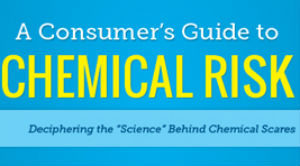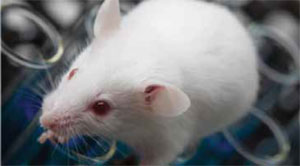 |
“Beepocalypse” Not: Alarmist Honeybee Claims Collapse Under Scrutiny, By Angela Logomasini, Ph.D. If you believe the headlines, honeybees may soon be endangered, pesticides are to blame, and regulations offer an easy solution. Yet headlines belie the truth of the matter. Beekeepers do face some significant challenges but these problems are not primarily driven by pesticides. Rather, beekeepers have suffered losses mostly due to the health of the honeybee hives driven mainly by natural forces. |
 |
A Consumer’s Guide to Chemical Risk, By Angela Logomasini, Ph.D. Will these chemicals make me fat? That sounds like a weird question, but some consumers may actually have such worries, thanks to a constant barrage of news headlines suggesting that synthetic chemicals—an even some naturally occurring ones—are responsible for nearly every public health problem imaginable. This booklet are designed reduce both the confusion and fear about chemicals. It provides consumers with some insights on the science and the politics behind the headlines. |
 |
Rachel Was Wrong: Agrochemicals’ Benefits to Human Health and the Environment, by Angela Logomasini, Ph.D. This year marks the 50th anniversary of biologist Rachel Carson’s 1962 book, Silent Spring, which argued that man-made chemicals represented a grave threat to human health and the environment. History has proven Carson’s claims wrong. The adverse impacts of pesticides on human health and the environment are often greatly exaggerated and history shows that these risks can be managed to ensure substantial net benefits. |
 |
The Real Meaning of TSCA Modernization: The Shift from Science-Based Standards to Over-Precaution, by Angela Logomasini, Ph.D. Many interests say that it is time to “modernize” the Toxic Substances Control Act, the federal law that regulates chemicals not covered under other federal laws. Some say the law needs an overhaul because it is too weak, while others maintain that changes to facilitate greater data collection and chemical testing could improve implementation. Both views suggest that reforms should grant the EPA greater powers to advance public health. In reality, changes to TSCA are highly unlikely to have any measurable positive effect. |
 |
The Report on Carcinogens: What Went Wrong and What Can Be Done to Fix It, by Richard B. Belzer. Should consumers panic every time they hear that the government has classified another chemical as a “carcinogen? Not at all. There is nothing wrong in principle with publishing periodic reports identifying substances that pose carcinogenic risks to humans. But it would be a mistake to continue basing these reports on scientific knowledge and primitive technology dating from the 1960s. |
 |
Green Chemistry’s March of the Ostriches, by Angela Logomasini and Daniel J. Murphy.n an age of routine life-enhancing improvements, self-appointed public policy ostriches are spreading myths as divorced from reality as those surrounding the ostrich. The myths envelop man-made chemicals. Advocates wave an innocent-looking banner extolling “green chemistry,” which in reality involves government second guessing decisions made within the private sector to force industry to make more “environmentally sound” or “green” products. This movement has succeeded in pressing its anti-chemicals agenda in numerous state capitals, and is trying to take it nationwide. |
 |
True Story of Cosmetics, by Dana Joel Gattuso. The Campaign for Safe Cosmetics and its partner, the Environmental Working Group (EWG), are on a crusade to scare consumers away from using cosmetics and hygiene products that contain preservatives and other useful chemicals. As part of their effort to ban the use of synthetic ingredients from skin products, these environmental extremist groups are working to incite fear among consumers, making outrageous and bogus claims that we are poisoning ourselves by using lipstick, makeup, deodorants, skin creams, and even baby products. |
 |
Nature’s Hormone Factory,by Johnathan Tolman.For millions of years plants have been quietly producing chemicals. Through countless generations they have been perfecting a potpourri of chemicals, some benign some deadly. As the ability to detect, isolate, measure and test chemicals found in nature has progressed a starling fact has emerged: hundreds of plants appear to produce endocrine disrupters. |
 |
Anti-BPA Packaging Laws Jeopardize Public Health, by Angela LogomasiniBPA bans will do little for public health, since they do not address significant risks. They are part of an ever-expanding arbitrary regulatory state that places many valuable products and freedoms at risk. The fact that some states and localities and even Congress are considering proposals to ban all BPA use in cans and other food and beverage containers illustrates this dangerous progression. |
 |
Brominated Flame Retardants, By William P. Kucewicz. A class of brominated flame retardants are under assault from environmental activists and regulators. Current evidence shows that the benefits of these flame retardants far outweigh any demonstrated or likely negative health effects from their use. Nevertheless, U.S. and European regulators have effectively banned two of the three most prominent PBDE flame retardants. An assortment of states, environmental groups, and foreign governments, moreover, is seeking to ban the third one (i.e., decaBDE) as well, even though there is no credible evidence that the chemical represents a danger to humans or the environment. |
More Research
Global Chemical Regulations: In February 2006, at the United Nations Environment Programme’s (UNEP) International Conference on Chemicals Management in Dubai, United Arab Emirates, more than 100 governments adopted a plan to implement the UNEP’s Strategic Approach to International Chemicals Management (SAICM) initiative. SAICM is designed to set up a global chemicals agency to coordinate management of chemicals, wastes, and other substances on a global scale. Read more in The U.N.’s Strategic Approach to International Chemicals Management Program: Stealth Attempt at Global Regulation By Angela Logomasini
REACH: European Chemical Regulation: Regulations enacted in the European Union (EU) increasingly are having worldwide impacts, warranting greater attention among policymakers in the United States and around the world. Not only do EU directives affect the 25 EU member nations, EU regulations can become trade barriers and impact thousands of businesses around the globe that are directly or indirectly linked to the EU’s substantial share in the world market though international trade. Read more in Europe’s Global REACH: Costly for the World; Suicidal for Europe, By Angela Logomasini
Pesticides & Disease Control: Ever since the mosquito-transmitted West Nile Virus appeared in New York City during 1999, environmental activists have been fighting efforts to keep the disease under control. Not only have they battled against any spraying for adult mosquitoes, they have also fought methods to manage mosquito larvae. Read more in Pesticides and the West Nile Virus An Examination of Environmentalist Claims, by Angela Logomasini
Regulation of chemicals used in plastics/Phthalates: Led by Greenpeace, environmental and “consumer” activist groups have implemented a worldwide campaign to ban polyvinyl chloride, or PVC, a plastic that contains chemicals collectively referred to as phthalates. Phthalates are used to soften these plastics, giving PVC—more commonly known as vinyl—qualities which make it useful not only for such things as children’s toys, but also for critically important medical devices. In particular, vinyl is used to make medical tubing, blood bags, IV bags, and gloves. In fact, 25 percent of all medical products are made with vinyl. Read more in Poisonous Propaganda: Global Echoes of an Anti-Vinyl Agenda, By Bill Durodié
Green attack on chlorine: The environmentalists are right about one thing: Dirty water kills. Millions are people are dying needlessly all over the world because of it. But are the main culprits man-made pollution and chlorinated chemicals? Try endemic poverty, bad plumbing and lack of access to basic water chlorination techniques. Read more in Rachel’s Folly: the End of Chlorine, By Michelle Malkin and Michael Fumento

